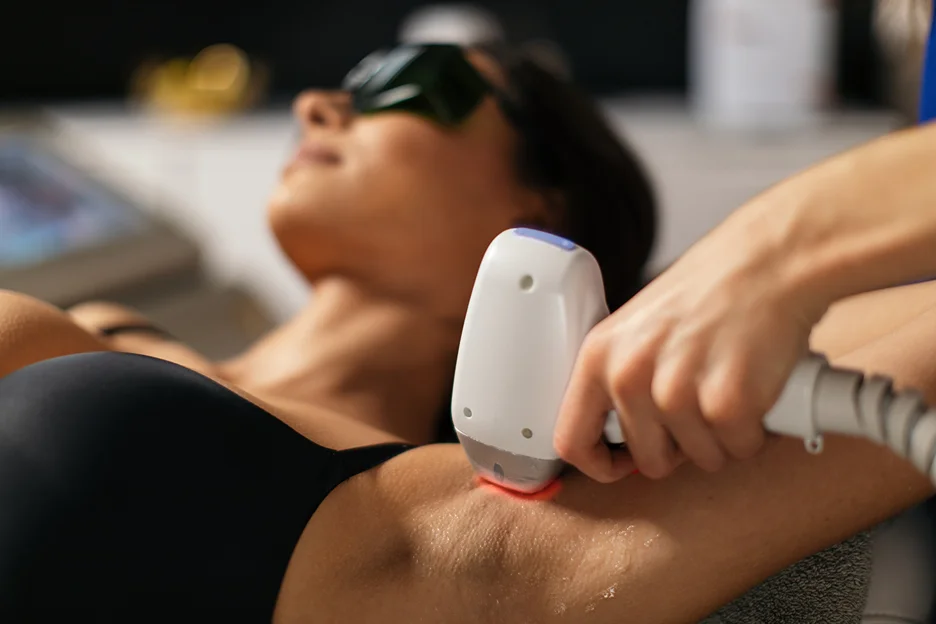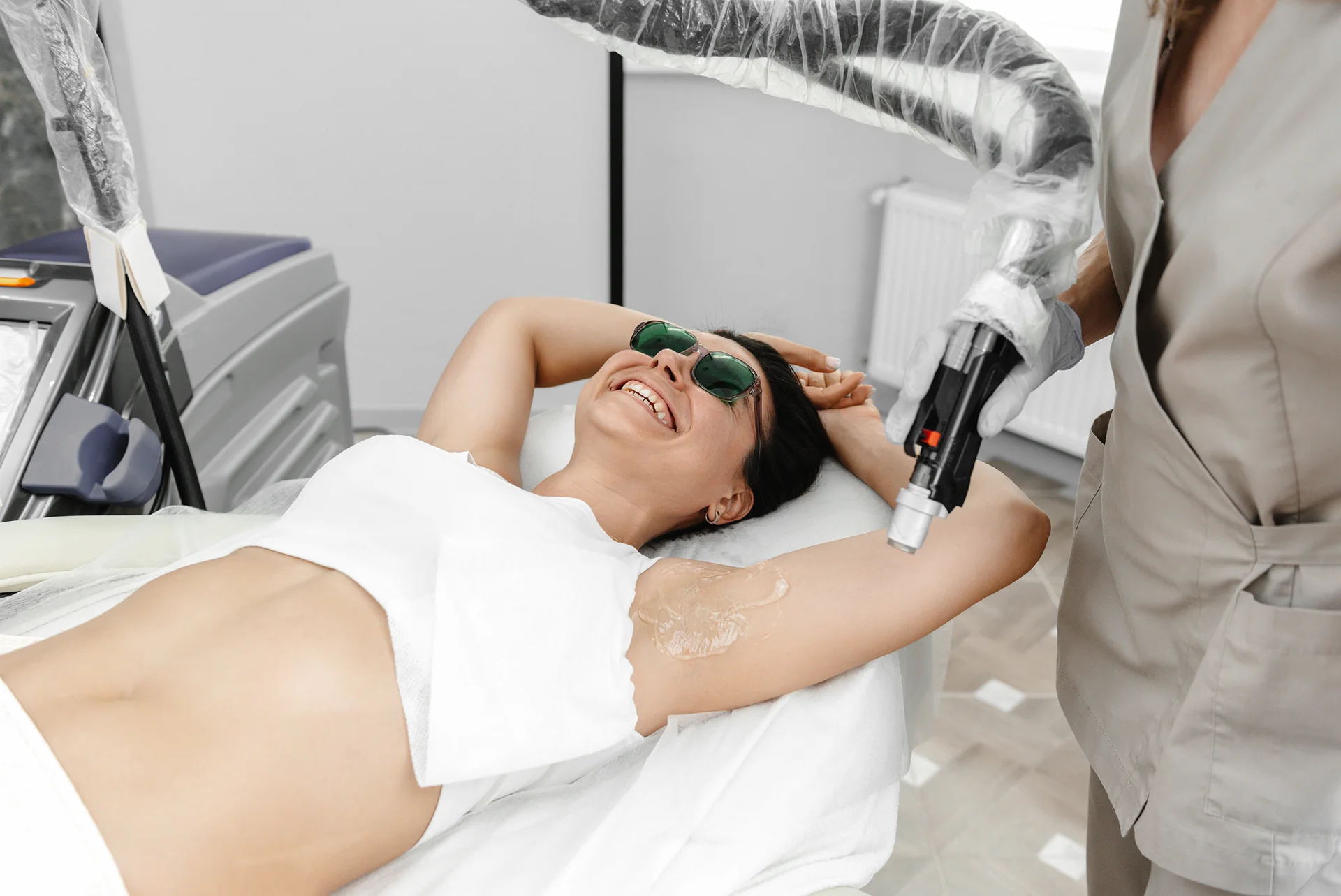A Comprehensive Guide to Optimizing Results
Smooth, hair-free skin is often the holy grail for many individuals looking to achieve flawless skin. The quest to keep unwanted body hair growth under control can seem never-ending, with endless shaving, plucking, waxing and using depilatory creams. However, with advanced laser hair removal treatments, there is now an effective and safe option for long-term hair reduction.
Laser hair removal has revolutionized the world of unwanted hair removal. This advanced treatment option uses concentrated beams of laser light to target the melanin pigment in hair follicles, effectively damaging the hair root and impeding future hair growth. With a series of successive laser hair removal sessions spaced optimally apart, patients can achieve up to permanent hair reduction and be on their way to silky smooth skin.
The Basic Principle of Laser Hair Removal

Laser hair removal works on the basic principle of using heat energy from a concentrated laser beam to damage the hair follicle enough to significantly delay or permanently stop hair regrowth. A laser hair removal machine emits a precise beam of laser light at a specific wavelength tailored for hair removal procedures. This concentrated beam of laser light is selectively absorbed by the melanin pigment naturally present in hair follicles.
Melanin provides color to hair strands, with darker hair containing higher levels of melanin. As the melanin absorbs the laser beam, it transforms the light energy into heat energy, effectively raising the temperature of the hair follicle and the surrounding tissue. This localized increase in temperature damages the hair follicle enough to stunt hair regrowth. With each successive laser hair removal treatment session, more hair follicles are damaged until hair growth is significantly reduced or eliminated permanently in the treated area.
In contrast to traditional methods of hair removal like shaving, waxing, sugaring or plucking, laser hair treatment damages the actual hair follicle located deep within the skin. Other hair removal methods only remove the hair shaft above the skin’s surface, allowing the follicle to remain intact and regenerate new hair later. By directly targeting the hair root, laser hair removal provides much longer-lasting hair reduction compared to superficial hair removal techniques.
Understanding the Natural Hair Growth Cycle
Hair follows a predictable growth cycle with three distinct stages – the anagen, catagen and telogen phases.
- The anagen phase is the active growth stage when the lower portion of the hair follicle forms new hair cells and pushes them upward to the skin’s surface. This phase can last anywhere from two to six years with hair growing about 1 centimeter per month.
- The catagen phase is a short transitional phase marking the end of active hair growth.
- Finally, the telogen phase is a resting stage when the hair follicle remains dormant for two to four months before the cycle starts again.
Laser hair removal is most effective when performed during the early anagen, or active growth phase, when hair follicles have a fresh supply of melanin pigment. The heat from the laser’s energy can easily damage the hair bulb and stem cells responsible for new hair production.
Trying to target hair follicles in the catagen or telogen stages is less effective since they are no longer metabolically active. This is why multiple successive laser hair removal treatment sessions scheduled at certain intervals are necessary to catch all hairs in the early anagen growth stage.
Factors Determining the Length Between Sessions
Optimal timing between laser hair removal sessions depends on several factors like skin type, hair color, location of hair growth, hormone levels and individual hair growth cycles. Understanding how these factors impact hair regrowth allows for ideal spacing between treatments.
Skin Type
Laser hair removal works best on individuals with light skin and dark coarse hair. Melanin in darker hair absorbs laser energy better leading to more effective damage of hair follicles. In contrast, fine, light hair has low concentrations of melanin making it harder to heat and destroy the follicle. At the same time, darker skin types have higher levels of melanin which competes with absorption by hair follicles.
This puts patients with dark skin tones at higher risk for adverse effects like skin burns or hyperpigmentation. Using laser devices with longer wavelengths tailored for darker skin can minimize risks and achieve better results. Adjusting settings based on skin color and utilizing cooling techniques helps protect the skin.
| Skin Type | Treatment Frequency | Additional Considerations |
| Lighter skin | Every 4-6 weeks | Minimal risks with frequent treatments |
| Darker skin | Every 6-8+ weeks | Longer intervals needed for healing and to reduce side effects |
| Tanned skin | Needs to avoid sun exposure after treatments | Higher melanin levels increase risks, so winter months ideal |
Hair Color and Type
Lasers work best on course, dark terminal hairs. This includes thick hair growth on arms, legs, backs, chests, bikini areas and beards. Light vellus hairs, like peach fuzz on the face, and white, blonde or red hair have low melanin content. They require more treatments over longer periods for minimal effects.
| Area | Recommended Treatment Interval | Reasoning |
| Bikini line | 4 weeks initially | Areas with fast hair regrowth need shorter intervals |
| Facial hair | 7-10 days | Facial hair growth is rapid, needing short intervals |
| Underarms | 6-8 weeks | Underarms, arms and legs can be treated every 6-8 weeks |
| Arms | 6-8 weeks | Underarms, arms and legs can be treated every 6-8 weeks |
| Legs | 6-8 weeks | Underarms, arms and legs can be treated every 6-8 weeks |
Hair Growth Patterns and Hormone Fluctuations
Androgen hormones like testosterone fuel hair follicle growth. Elevated androgen levels during puberty, pregnancy and certain medical conditions can stimulate excess, unwanted hair growth called hirsutism in women. Targeting androgen production and hair follicles with lasers helps control hair regrowth.
The natural hair growth cycle has periodic fluctuations where hair follicles are more active. During fall and winter, our bodies grow more hair to insulate in cold weather. Spring and summer see increased hair shedding. Knowing when unwanted hair growth is more active lets patients time laser sessions accordingly.
Preparation and Initial Consultation
The first step for laser hair removal is always an initial consultation with a certified dermatologist, plastic surgeon or trained laser technician. During this visit, they evaluate your medical history, skin type, hair color, location of unwanted hair growth, and realistic expectations. An experienced laser hair removal specialist develops customized treatment plans with optimal laser settings and intervals between sessions.
They often advise avoiding sun exposure, tanning beds, chemical peels, Botox, and depilatory creams for 4-6 weeks before starting laser treatments. This minimizes risks of skin reactions and interference with laser light absorption. Patients should shave treatment areas instead of plucking or waxing which temporarily removes the hair follicle. For best results, the initial consultation should occur during a period of active hair growth.
The Typical Laser Hair Removal Journey
Most patients require multiple laser hair removal treatment sessions spaced weeks apart to achieve desired results. For large body areas, the typical interval between initial sessions is 4-6 weeks. People with facial hair need more frequent treatments like every 10-14 days until hair growth starts to diminish.
Why the need for successive treatments scheduled closely together?
The natural hair cycle means only a fraction of follicles are active and vulnerable to laser damage at one time. Shorter intervals hit new hairs as they enter the early anagen growth phase.
As hair density decreases over 3-6 initial treatments, the time between sessions can be extended to 6-8 weeks for the body and 3-4 weeks for the face. This continues for up to 8-12 sessions based on patient goals for hair reduction versus permanent hair removal.
Ongoing maintenance treatments are often needed 2-4 times per year long-term to sustain results and catch stray regrowth. Consistent intervals and correct timing is key for successful laser hair removal journeys.
What to Expect During and After a Laser Hair Removal Session
During the procedure, eye protection shields are provided. Cooling techniques like air blowing, cooling gel or chilled device tips help make treatments comfortable. Most patients describe the laser pulses to feel like a rubber band snaps on the skin.
While not extremely painful, the laser can cause some discomfort or stinging which lasts just milliseconds. Topical anesthetics prescribed by the clinician can help reduce these sensations. Treated areas often have mild redness and swelling afterwards, similar to a sunburn, lasting from a few hours to a couple days.
Laser technicians provide aftercare instructions for gentle skin cleansing, avoiding sun exposure, moisturizing and not using products that could irritate the skin. Avoiding hot baths or showers, swimming pools and makeup for 2-3 days helps prevent adverse effects.
Most people can resume normal activities immediately with minimal downtime. Over-the-counter pain medication manages residual tenderness. Mild redness may last several days. Schedule laser sessions accordingly to allow for sufficient healing time.
Final Thoughts

Laser hair removal can successfully free patients from the constant hassle of shaving and waxing, offering the chance for permanent reduction in unwanted body and facial hair growth. But the key is following the ideal treatment schedule and intervals between laser sessions. Consulting a board-certified dermatologist or laser hair removal specialist provides tailored guidance so patients can optimize the results of this effective hair removal option.
Achieving smooth skin through laser hair removal is an investment in time, patience and proper technique. But the rewards of long-term silky soft skin and freedom from unattractive excess hair growth makes it well worth it for most. Contact a reputable laser clinic like Ethos Aesthetics + Wellness today to schedule a complimentary consultation and get started on enjoying smooth confidence.







